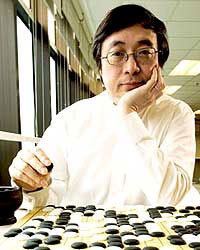Name Feng-hsiung Hsu Role Computer scientist | ||
 | ||
Books Behind Deep Blue: Building the Computer that Defeated the World Chess Champion | ||
Feng-hsiung Hsu (Chinese: 許峰雄; pinyin: Xǔ Fēng Xióng) (nicknamed Crazy Bird) is a computer scientist and the author of the book Behind Deep Blue: Building the Computer that Defeated the World Chess Champion. His work led to the creation of the Deep Thought chess computer, which led to the first chess playing computer to defeat Grandmasters in tournament play and the first to achieve a certified Grandmaster level rating.
Contents
Hsu was the architect and the principal designer of the IBM Deep Blue chess computer. He was the recipient of the 1990 Mephisto Award for his doctoral dissertation and also the 1991 ACM Grace Murray Hopper Award for his contributions in architecture and algorithms for chess machines.
Career
Hsu was born in Keelung, Taiwan, and came to the United States after graduating from National Taiwan University with B.S. in E.E.. He started his graduate work at Carnegie Mellon University in the field of computer chess in the year 1985. In 1988 he was part of the "Deep Thought" team that won the Fredkin Intermediate Prize for Deep Thought's Grandmaster-level performance. In 1989 he joined IBM to design a chess-playing computer and received a Ph.D. with honors from Carnegie Mellon University.
In 1991, the Association for Computing Machinery awarded Hsu a Grace Murray Hopper Award for his work on Deep Blue. In 1996, the supercomputer lost to world chess champion Garry Kasparov. After the loss, Hsu's team prepared for a re-match. During the re-match with Kasparov, the supercomputer had double the processing power it had during the previous match. On May 11, 1997, Kasparov lost the sixth and final game, and, with it, the match (2½-3½).
Prior to building the supercomputer Deep Blue that defeated Kasparov, Hsu worked on many other chess computers. He started with ChipTest, a simple chess-playing chip, based on a design from Unix-inventor's Ken Thompson's Belle, and very different from the other chess-playing computer being developed at Carnegie Mellon, HiTech, which was developed by Hans Berliner and included 64 different chess chips for the move generator instead of the one in Hsu's series. Hsu went on to build the successively better chess-playing computers Deep Thought, Deep Thought II, and Deep Blue Prototype.
Hsu now manages the platforms and devices center of Microsoft Research Asia, in Beijing. He has stated the view that brute-force computation has eclipsed humans in chess, and it could soon do the same in the ancient Asian game of Go.
